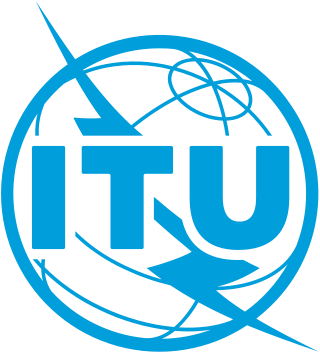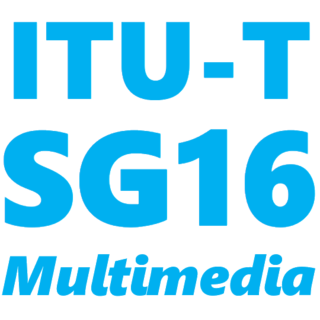
The International Telecommunication Union Telecommunication Standardization Sector (ITU-T) is one of the three Sectors (branches) of the International Telecommunication Union (ITU). It is responsible for coordinating standards for telecommunications and Information Communication Technology, such as X.509 for cybersecurity, Y.3172 and Y.3173 for machine learning, and H.264/MPEG-4 AVC for video compression, between its Member States, Private Sector Members, and Academia Members.

The International Telecommunication Union (ITU) is a specialized agency of the United Nations responsible for many matters related to information and communication technologies. It was established on 17 May 1865 as the International Telegraph Union, making it the oldest UN agency. Doreen Bogdan-Martin is the Secretary-General of ITU, the first woman to serve as its head.
In computer networking and telecommunications, a pseudowire is an emulation of a point-to-point connection over a packet-switched network (PSN).

A passive optical network (PON) is a fiber-optic telecommunications technology for delivering broadband network access to end-customers. Its architecture implements a point-to-multipoint topology in which a single optical fiber serves multiple endpoints by using unpowered (passive) fiber optic splitters to divide the fiber bandwidth among the endpoints. Passive optical networks are often referred to as the last mile between an Internet service provider (ISP) and its customers. Many fiber ISPs prefer this technology.
The Video Coding Experts Group or Visual Coding Experts Group is a working group of the ITU Telecommunication Standardization Sector (ITU-T) concerned with standards for compression coding of video, images, audio, and other signals. It is responsible for standardization of the "H.26x" line of video coding standards, the "T.8xx" line of image coding standards, and related technologies.
ITU-T Recommendation G.983 is a family of recommendations that defines broadband passive optical network (BPON) for telecommunications Access networks. It originally comprised ten recommendations, G.983.1 through G.983.10, but recommendations .6–.10 were withdrawn when their content was incorporated into G.983.2. The current view is that the BPON standards are mature, and no further work will be done on them after the 2007 round. The GPON OMCI definition has been revised to stand alone, rather than citing G.983.2.
G.984 is the ITU-T standard for implementing a gigabit-capable passive optical network (GPON). It is commonly used to implement the outermost link to the customer of fibre-to-the-premises (FTTP) services.
T-MPLS or Transport MPLS is a transport network layer technology that uses extensions to a subset of the existing MPLS standards and is designed specifically for application in transport networks. Work to define T-MPLS was started by the ITU-T in February 2006. It was intended specifically as a connection-oriented packet-switched (co-ps) application offering a simpler implementation by removing MPLS features that are not relevant to co-ps applications and adding mechanisms that provide support of critical transport functionality.
In telecommunications, Multiprotocol Label Switching - Transport Profile (MPLS-TP) is a variant of the MPLS protocol that is used in packet switched data networks. MPLS-TP is the product of a joint Internet Engineering Task Force (IETF) / International Telecommunication Union Telecommunication Standardization Sector (ITU-T) effort to include an MPLS Transport Profile within the IETF MPLS and PWE3 architectures to support the capabilities and functionalities of a packet transport network.
10G-PON is a 2010 computer networking standard for data links, capable of delivering shared Internet access rates up to 10 Gbit/s over existing dark fiber. This is the ITU-T's next generation standard following on from GPON or Gigabit-capable PON. Optical fibre is shared by many subscribers in a network known as FTTx in a way that centralises most of the telecommunications equipment, often displacing copper phone lines that connect premises to the phone exchange. Passive optical network (PON) architecture has become a cost-effective way to meet performance demands in access networks, and sometimes also in large optical local networks for "Fibre-to-the-desk".
MPEG-H is a group of international standards under development by the ISO/IEC Moving Picture Experts Group (MPEG). It has various "parts" – each of which can be considered a separate standard. These include a media transport protocol standard, a video compression standard, an audio compression standard, a digital file format container standard, three reference software packages, three conformance testing standards, and related technologies and technical reports. The group of standards is formally known as ISO/IEC 23008 – High efficiency coding and media delivery in heterogeneous environments. Development of the standards began around 2010, and the first fully approved standard in the group was published in 2013. Most of the standards in the group have been revised or amended several times to add additional extended features since their first edition.
ISO/IEC JTC 1/SC 25 Interconnection of information technology equipment is a standardization subcommittee of the Joint Technical Committee ISO/IEC JTC 1, of the International Organization for Standardization (ISO) and the International Electrotechnical Commission (IEC), which develops and facilitates standards within the field of interconnection of information technology equipment. The international secretariat of ISO/IEC JTC 1/SC 25 is the Deutsches Institut für Normung (DIN) located in Germany.
NG-PON2, Next-Generation Passive Optical Network 2 is a 2015 telecommunications network standard for a passive optical network (PON). The standard was developed by ITU and details an architecture capable of total network throughput of 40 Gbit/s, corresponding to up to 10 Gbit/s symmetric upstream/downstream speeds available at each subscriber.
G.657 is an international standard developed by the Standardization Sector of the International Telecommunication Union (ITU-T) that specifies single-mode optical fiber (SMF) cable.

The ITU-T Study Group 16 (SG16) is a statutory group of the ITU Telecommunication Standardization Sector (ITU-T) concerned with multimedia coding, systems and applications, such as video coding standards. It is responsible for standardization of the "H.26x" line of video coding standards, the "T.8xx" line of image coding standards, and related technologies, as well as various collaborations with the World Health Organization, including on safe listing (H.870) accessibility of e-health (F.780.2), it is also the parent body of VCEG and various Focus Groups, such as the ITU-WHO Focus Group on Artificial Intelligence for Health and its AI for Health Framework.
G.651.1 is an international standard developed by the Standardization Sector of the International Telecommunication Union (ITU-T) that specifies multi-mode optical fiber (MMF) cable.
Higher Speed PON is a family of ITU-T recommendations for data links, capable of delivering shared Internet access rates up to 50 Gbit/s. Higher Speed PON is the first PON system to use digital signal processing, succeeding both single-channel XGS-PON and multi-channel NG-PON2. It provides upgrade paths for legacy PON generations such as GPON, XG-PON, XGS-PON, and 10G-EPON.

The World Telecommunication Standardization Assembly (WTSA) is the governing conference of the ITU Standardization Sector (ITU-T), one of the three world conferences of the International Telecommunication Union, and as such, the United Nations system. The quadrennial conference decides the working methods for ITU-T for the next Study Period. It also creates the Telecommunication Standardization Advisory Group (TSAG) and the ITU-T Study Groups and elects their management teams. The Recommendations and resolutions that are approved at WTSA shape the future of ICT standardization.

The ITU-T Study Group 17 (SG17) is a statutory group of the ITU Telecommunication Standardization Sector (ITU-T) concerned with security. The group is concerned with a broad range of security-related standardization issues such as cybersecurity, security management, security architectures and frameworks, countering spam, identity management, biometrics, protection of personally identifiable information, and the security of applications and services for the Internet of Things (IoT). It is responsible for standardization of i.a. ASN.1 and X.509, it is also the parent body of the Focus Group on Quantum Information Technology (FG-QIT). The group is currently chaired by Heung Youl Youm of South Korea.
The ITU-T Study Group 13 (SG13) is a statutory group of the ITU Telecommunication Standardization Sector (ITU-T) concerned with networks, infrastructure and cloud computing, including the networking aspects of mobile telecommunications. Examples include: Y.1564, Y.1731, etc.. Recent work includes a series of standards on using machine learning in networking, such as Y.3172, Y.3173, Y.3176, and Y.3181.






